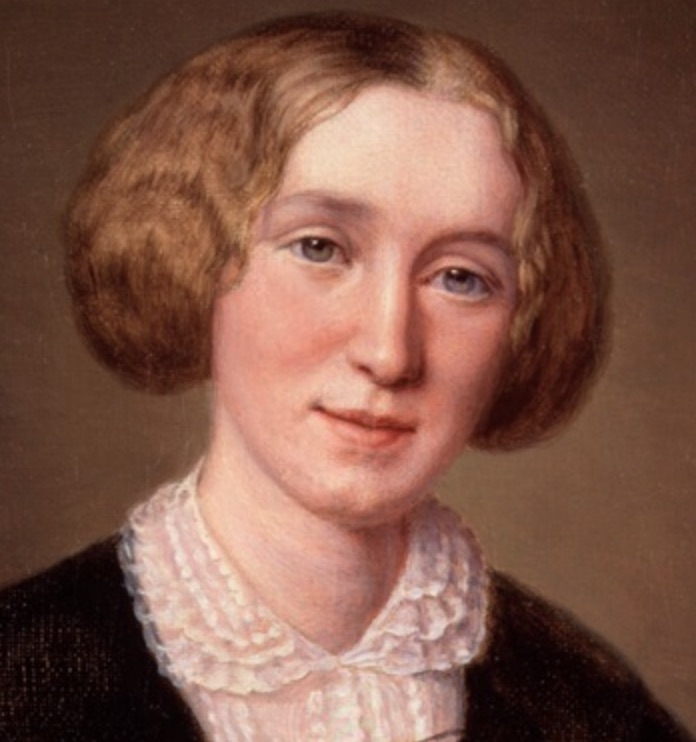
George Eliot was the pen name of Mary Ann Evans, who was born on November 22, 1819, in Nuneaton, Warwickshire, England to Christiana Pearson Evans and Robert Evans, a land agent. Recognizing that Mary Ann was intelligent, but fearing that his daughter may not be attractive enough to get a husband, Robert invested in her education. From ages 5 to 16, Mary Ann attended a series of boarding schools where she received instruction in English composition, Latin, French and German as well as exposure to religious education. After she graduated from the last boarding school, Mary Evans immersed herself in the library of Arbury Hall where she poured through classical literature, and particularly the ancient Greek tragedies,
When her mother died in 1836, Mary Ann, not yet 17 years of age, returned to the family home to serve as housekeeper for her father and siblings. When her brother Isaac married, he took over the family home, and Mary Ann and her father moved to Foleshill near Coventry. In Coventry, Mary Ann met the wealthy entrepreneur, philanthropist and free-thinking Charles Bray. Although Bray was married, Mary Ann and he shared an intimate relationship while Mary Ann still remained a close friend of Bray’s wife. Through Charles Bray, Mary Ann met several of the radical, free-thinkers among the intelligentsia in English high society. Visitors to the Bray estate included Herbert Spencer, Robert Owen, Harriet Martineau and Ralph Waldo Emerson.
Mary Ann’s career in literature began with her 1846 English translation of David Strauss’s Das Leben Jesu kritisch bearbeitet translated into English, as The Life of Jesus, Critically Examined. Bray helped Mary Ann launch her career as a writer by publishing in his newspaper, the Coventry Herald and Observer, some of her reviews and writings. When Mary Ann’s father died in 1849, Mary Ann, at the age of 30 moved to Geneva, Switzerland with the Brays. The following year she returned to London to become an assistant editor for the Westminster Review, a prominent literary magazine of the time. Her work as a translator had exposed her to various avant-garde philosophical and theological ideas that had a dramatic impact on her thinking. In one of her last essays published in 1856 in the Westminster Review, titled “Silly Novels by Lady Novelists,” she ridiculed the vacuous plots and superficial perspectives of the fiction authored by women.
In 1857, as she prepared to write her own novels, Mary Ann attempted to distance herself from the “silly novels” of female authors by choosing a male pen name. She had been living common law, since 1854, with philosopher George Henry Lewes, so she combined his first name, “George” with the name “Eliot” that was easy to spell and pronounce, ultimately obtaining the name for which she would be remembered–George Eliot.
In the next 13 years, George Eliot authored four great novels that remain among the most celebrated works in English literature. Adam Bede, published in 1859 reflects some of the ideas spawned in Germany during the Protestant Reformation and presents some different perspectives on human responsibility, autonomy and empathy. The Mill on the Floss (1860) draws upon her childhood, contrasting the recall of childhood experiences with the actual occurrences. Silas Marner (1861) has a simpler plot than the others as it explores themes of redemption, industrialism and the individual against the community. Middlemarch (1871–1872) often considered her masterpiece, is a complex and multi-faceted novel, exploring various aspects of provincial life, including religion, self-interest, the status of women, the nature of marriage, hypocrisy, political reform, and education. Reflecting on the need for tolerance, Eliot asserted, “The responsibility of tolerance lies with those who have the wider vision.”
George Eliot faced criticism and controversy in her personal life on account of her unconventional relationship with George Henry Lewes, a married man. Although George Eliot and George Henry never married, they lived together as partners for over two decades until Lewes’s death in 1878. Despite the public criticism, George Eliot continued to write and publish. She married John Cross in 1880, but died in Chelsea, London on December 22, of that year, at the age of 61, from complications related to a throat infection. George Eliot’s novels remain influential and are studied for their exploration of social issues, psychological depth, and moral complexity. Her contributions to Victorian literature and her unique narrative style have secured her a lasting place in literary history.
